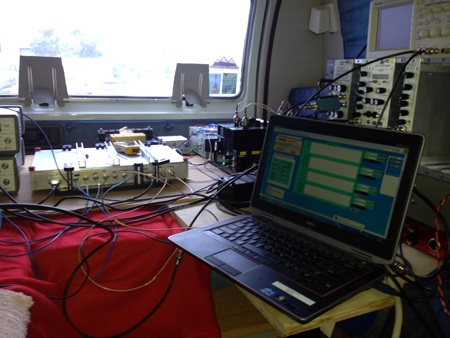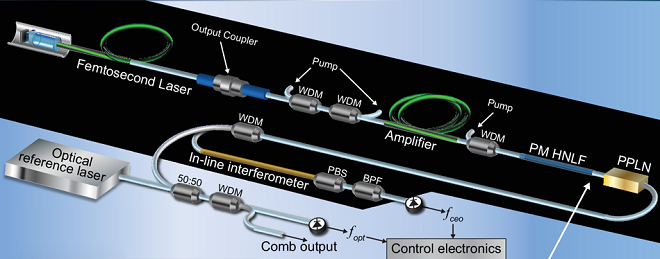March 20, 2014
A PML team is hitting the road with a fine-tooth comb. Scientists in the Quantum Electronics and Photonics Division have devised a portable optical frequency comb that is capable of laboratory-grade measurements but can be operated outside of the laboratory at remotes sites, and even on moving platforms.
That capability not only provides for sensitive optical-frequency time transfer in non-laboratory settings, but may also make possible new levels of precision in detecting greenhouse gas concentrations, monitoring industrial processes for contaminants, and – eventually – measuring changes in local gravitational field that alter a clock's tick rate. "The main impetus behind the project is time transfer," says co-developer Laura Sinclair of the Fiber Sources and Applications Project. "Without the presence of fiber-optic cable, how do you compare optical clocks? Synching them to GPS signals won't work because those microwave signals have stabilities orders of magnitude below what you need.
"So the solution is to do optical time transfer. You can take two of these combs, reference them to two separate atomic clocks, and then exchange pulses between the combs to see timing differences with femtosecond precision. Of course, that means that the equipment has to travel."
Which it demonstrably can: In a series of tests last year, the device was operated in the back of a borrowed camper van, where it was exposed to vibration from dips, speed bumps, and gravel roads that generated accelerations exceeding 0.5 g. It was also tested on a laboratory shaker table under even stronger vibrations and a broad range of frequencies.
In both cases, the difference in performance from controlled laboratory conditions was relatively small. Pulse-to-pulse timing jitter was approximately 3 fs in the lab, and about 5 fs on the road. In both venues, the comb-tooth line width was on the order of 1 Hz, and pulses fluctuated less than 1 radian in phase. The group reports its results in a forthcoming issue of Optics Express.
That original test unit (see photo below) was about the size of a DVR, occupying a volume of ~ 6 liters, not counting the associated electronics. Since then, Sinclair and co-developers Ian Coddington and William Swann along with colleague Lindsay Sonderhouse have shrunk the dimensions six-fold.
Making a frequency comb portable was a formidable challenge that eventually took more than a year and a half to overcome and involved rethinking the entire system, from the configuration of the primary oscillator – a 200 MHz, femtosecond-pulse, mode-locked fiber laser that drives the system – to the fibers that carry the signals. To achieve the required level of performance, the redesign had to still be stabilized by an optical reference laser. The reference laser is continuously compared to a single tooth of the comb, and the instantaneous difference between the two signals (detected by interferometry) is used to adjust cavity length in the primary laser via piezoelectric actuators.
"After suitable fiber lasers became a proven technology, everybody assumed that fiber combs were going to replace those made by titanium-sapphire lasers," says Coddington. "Unfortunately, a lot of early designs were based on a scheme that involves squeezing the fiber just the right way, and that turns out to be sensitive to everything under the sun. The alignment is more stable than a Ti:Sapph, but if you breathe on it wrong, everything still collapses. There was much hope that you could actually take these early fiber combs out in the field.
"Our goal was to find a design which could get around all of that. You had to take that oscillator – the central guts of the system – and just throw out all the old components. That's where a lot of the exploration happened. We got a lot of the new devices and materials that have only recently become available, and started hooking them up in different ways. Laura was able to set up a lot of open bench systems to test a whole lot of combinations."
One key decision was the use of telecom-grade, polarization-maintaining fibers for all connections. "It's inherently less sensitive to fluctuations," says Sinclair. "You can bend it or tap on it, and it stays mode-locked."

The initial version of the portable frequency comb (inside metal enclosure, left center) is tested as it rides across bumps and dips in the back of a camper van, powered by an on-board generator.
Finally by mid-2013 they had a finished design for prototyping. "But until we plugged them in," Coddington says, "we had no idea if they would work in the field." They started by driving a prototype around a NIST parking lot, and then eventually all over the approximately 200 acre NIST campus.
The successful result of those tests opens the door to a host of potential applications, from molecular spectroscopy in manufacturing settings (where devices would have to be portable and robust) to more exotic uses such as searching for subterranean deposits of solids or fluids that would cause excursions in the local gravitational field – and hence variations in clock speed.*
"If you're doing that in the field," says Coddington, "chances are you won't have a laboratory-grade fiber-optical network to use. But suppose you had two identical vans, each carrying a clock and a connected portable comb device. They would be far apart, but you would link them up periodically to see the difference in each clock's tick rate. PML's Fabrizio Giorgetta and colleagues here recently demonstrated that combs could be used to compare two clock separated by a few kilometers with 1 femtosecond stability, sufficient to detect small changes in the Earth's gravitational field."
In the near term, however, the scientists hope to use their system to do sensitive measurements of atmospheric carbon. Carbon dioxide absorbs infrared radiation in the wavelength range of 1560 to 2000 nm. The current portable comb's primary laser output is centered at 1550 nm, but extends out past 2130 nm.
One promising possibility is a collaboration with carbon-monitoring efforts at the National Oceanic and Atmospheric Administration. "They're very interested in a sensor that integrates over a path on the kilometer scale," Coddington says. "Our comb beams can do that. It would be an accurate way to measure higher CO2 or methane concentrations in certain areas, or conversely to characterize the way, for example, that other areas act as carbon sinks."
"We have a long history of exploring frequency combs as an enabling tool for precision measurements along with a number of other groups at NIST and around the world," says Nathan Newbury, head of the Fiber Sources and Applications project. "This advancement is key to enabling some of the really promising comb-based measurement systems to leave the well-controlled laboratory environment and enter the real world."
The research was supported by the DARPA PULSE and QuASAR programs. K. Iwakuni of Keio University in Japan participated in fs laser development and testing.Greg Rieker now of the University of Colorado, Boulder participated in the mobile testing and Archita Hati of NIST participated in the vibration testing.
* This effect, called gravitational time dilation, was predicted by Albert Einstein in 1907 and has since been confirmed by numerous experiments. In general, the closer a clock gets to a large mass, the slower it will run. Mineral, petroleum, or other subterranean deposits cause variations in the local gravitational field, and a sufficiently sensitive clock could detect those changes. For a scholarly discussion of the subject by PML researchers, see http://www.sciencemag.org/content/329/5999/1630.short















